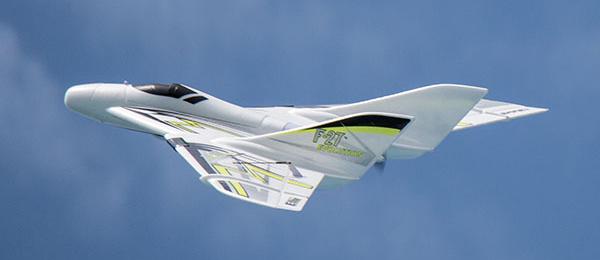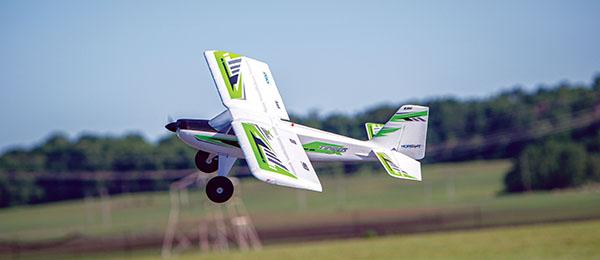Written by Matt Ruddick
Speed and stability refined
Product Review
As seen in the September 2018 issue of Park Pilot
Bonus Video
Product Review
The E-Flite F-27 Evolution, the new bigger brother of last year’s UM F-27 FPV, takes a proven streamlined design and modernizes it with some of the newest technology from Horizon Hobby’s E-flite line.Image

With the option of using a 3S or 4S LiPo battery pack, the F-27 Evolution has a wide flight envelope.
Features such as AS3X, SAFE Select, and high-quality EPO foam construction make the F-27 Evolution a great aircraft with which to speed your way into the world of fast-flying wings. As with all BNF Basic models, you must supply your own six-plus-channel Spektrum transmitter and battery. The F-27 Evolution is capable of running on either a 2,200 to 2,500 mAh 3S LiPo battery or an 1,800 to 2,200 mAh 4S LiPo. The battery hatch is located in the front of the fuselage and can be accessed by pressing the button near the front of the hatch. The battery powers a 10-size brushless outrunner motor and a 40-amp brushless ESC, providing plenty of thrust, which I’ll discuss later.
Image

The battery hatch has plenty of room for your LiPo battery pack and to adjust the center of gravity.
Assembly and Preflight
Inside of the box you’ll find the aircraft in six separate pieces, plus four carbon-fiber spars. Assembling the parts was quick and simple. You insert two spars on each side of the fuselage and slide the wing halves in place until the clips on each wing engage.Image

The F-27 Evolution is easy to assemble with its snap-together construction.
Horizon Hobby has included its new embedded servo system, so as you slide the wing halves on, the servos plug themselves in and you’re ready to go. Simply snap the vertical stabilizers into position until you feel those clips engage, twist the nose cone onto the front, and you’re ready to bind!
Image

Servo connectors are built into the wing and fuselage.
This model features AS3X with SAFE Select technology, so not only will you have stable and smooth flight characteristics, but SAFE Select will limit your pitch and bank angles, as well as automatically level the aircraft. This works great for first-time flying wing pilots who are unaccustomed to the aircraft’s intricacies. SAFE Select is either activated or deactivated during the binding process, so it is incredibly important to pay attention to the manual’s instructions for binding to know which procedure to follow. My recommendation is to begin with SAFE Select turned on because the takeoff assistance works incredibly well. During the setup process you’ll designate a switch that will turn this feature on and off, so as you progress, you can easily disable SAFE Select without going through the bind process again. For my flight, I was using a Thrust 1,800 mAh 4S LiPo battery pack; however, the F-27 isn’t ready to support 4S right out of the box. The Low-Voltage Cutoff (LVC) that is programmed into the ESC is set up for three-cell voltage. Thanks to the programming menu in the ESC, you are able to change the LVC using a combination of stick commands that are spelled out in the user’s manual. It is important to note that although the aircraft will still operate without making this change, you will likely damage your battery by overdischarging it. If you are unsure of which setting your ESC’s LVC is set to, plug in the battery and you will hear a series of tones: three tones for 3S and four for 4S.
Flight
Using SAFE Select, the takeoff process was fairly simple. If you’re familiar with flying-wing design, you’ll know that there are a few different techniques to launching an aircraft. Using SAFE Select, I made a gentle, level toss into the wind at approximately half to three-quarters throttle. That sent the F-27 Evolution climbing easily into the sky. This gave me enough time to get my hands on the controls. For those who are new to hand launching, it would be advisable to ask your spotter to toss the aircraft for you so that you can focus on flying. In the air, the Evolution glides effortlessly, thanks to its large surface area, oversize elevons, and aerodynamic shape. Cruising along at quarter to half throttle was enjoyable, and the AS3X was certainly keeping the whole flight stable, but let’s be honest here—this aircraft is designed for speed, and I wanted to see what that was like. I punched it to full throttle and there it was—speed I was unaccustomed to in such an easy-to-fly package. The F-27 sped through the air as though it was on a rail, going exactly where I wanted it to go. If I overuse the word “effortless” while discussing how the Evolution flies, it’s because it is the perfect adjective. It is simply a joy to fly this model around. It has nearly limitless vertical thrust, handles inverted flight with ease, and performes snap rolls in the blink of an eye. The overall flight time is approximately 5 minutes. Landing is easier than other flying wings I’ve tried in the past, thanks to the slow-speed characteristics of the F-27. I was able to set it down within a few feet of where I was aiming and, thanks to the plastic plates on the bottom, no harm will come to the EPO foam if you land on an asphalt runway. Even so, I would still aim for the grass.FPV
Although the F-27 Evolution isn’t an FPV flier out of the box like its smaller sibling, there is an optional FPV accessory you can get to turn it into an amazing FPV flying wing. The FPV nose features a preassembled camera and 150 mW video transmitter that replaces the standard nose cone that comes with the Evolution. I was unable to find specifications for the camera itself, but it operates similar to most standard 600 TVL cameras. Simply run the extended servo cable into the fuselage, plug it into the receiver then twist the nose cone into place and it’s ready to go. The simple process took fewer than 2 minutes to switch out.Image

The optional FPV nose cone offers a chance to scream across the sky in FPV!
Flying the Evolution in FPV mode was even more fun than line-of-sight flying. The field of view of the camera is nice and wide, so you get a great view of the flying field around you. When you’re flying at nearly 100 mph, FPV allows you to worry less about losing orientation and more about where you want to fly! I’m not always a fan of some of these optional accessories, but in this case, I’m making an exception. The FPV nose accessory is definitely worth the $44.99 price tag.
Conclusion
There are days when going out to the club field and flying a small glider or a Cub seems like the thing to do to relax; however, there are other days when you need to go out and make a big wing scream across the sky. That’s where the F-27 Evolution comes in. This aircraft is an absolute blast to fly when you really want an adrenaline rush. Don’t let it fool you because you can fly low and slow just as easily. That’s why I think this product could be a great tool for someone who wants to jump into flying wings, but also wants something that can expand with his or her abilities thanks to the wide range of operating speeds and SAFE technologies. The F-27 Evolution is on sale now and retails for $179.99.Image

The F-27 Evolution has a sleek and aerodynamic body shape.
—Matt Ruddick [email protected]










Comments
Lvc programming for 4s lipo
Once is programmed for 4s lipo, could I use 3s, or I need to reprogram to 3s lipo.
Thank you.
Add new comment